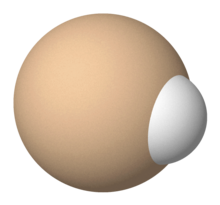
| |
| Names | |
|---|---|
| IUPAC name Silylidyne | |
| Systematic IUPAC name λ-silane | |
| Other names Hydridosilicon, Silylidine | |
| Identifiers | |
| CAS Number | |
| 3D model (JSmol) | |
| ChEBI | |
| ChemSpider | |
| Gmelin Reference | 254 |
| PubChem CID | |
InChI
| |
|
SMILES
| |
| Properties | |
| Chemical formula | HSi |
| Molar mass | 29.093 g·mol |
| Except where otherwise noted, data are given for materials in their standard state (at 25 °C , 100 kPa). Infobox references | |
Silylidyne is a chemical substance occurring as a molecule found in stars and probably existing in interstellar space, or as a monolayer on the surface of solid silicon. The SiH molecule is a radical, and can be made experimentally by striking an electric arc to silicon on a low pressure hydrogen gas.
Surface
As a surface layer, silicon hydrides form when the silicon is cleaned with hydrofluoric acid. These hydrides decompose to SiH when heated to 750 K. Other ways to coat a silicon surface in hydrogen is via reaction with atomic hydrogen, or hot silane. A (111) crystal face will become covered in the pure monohydride, but other faces on a silicon crystal will also have the dihydride and trihydride groups.
Group
The silylidyne group, not to be confused with silylidyne, is a ≡SiH group that is bonded with a triple bond. The hydrogen can be substituted by other groups to make a more generic family of silylidynes. It is known as a ligand on molybdenum.
Natural occurrence
Silylidyne in space was first noticed in sun spots in 1933. Later on it was found on the solar disk, photosphere, and in cool stars. Mira variable stars of type M or S may have emission lines of SiH. In even cooler brown dwarfs and planets, SiH is not found, but instead silicon takes form as silicon monoxide at low pressures, and SiH4 at high pressures. Minute amounts of SiH as a transient species may be found in these bodies as SiO and SiH4 react with water.
Properties
The Si-H bond strength is 80 kcal/mol.
Spectrum
The most prominent spectral band is due to AΔ → XΠ transitions. Higher level excited states are the BΣ and CΣ, DΔ, EΣ.
The life time of the molecules in the A state is 530 nanoseconds. They decay to the X ground state.
References
- Rochow, E. G. (2013). The Chemistry of Silicon: Pergamon International Library of Science, Technology, Engineering and Social Studies. Elsevier. ISBN 9781483187556.
- Sun, X. H.; Wang, S. D.; Wong, N. B.; Ma, D. D. D.; Lee, S. T.; Teo, Boon K. (April 2003). "FTIR Spectroscopic Studies of the Stabilities and Reactivities of Hydrogen-Terminated Surfaces of Silicon Nanowires". Inorganic Chemistry. 42 (7): 2398–2404. doi:10.1021/ic020723e. PMID 12665376.
- ^ Cheng, C. C.; Yates, J. T. (1991). "H-induced surface restructuring on Si(100): Formation of higher hydrides" (PDF). Physical Review B. 43 (5): 4041–4045. Bibcode:1991PhRvB..43.4041C. doi:10.1103/PhysRevB.43.4041. PMID 9997752. Archived (PDF) from the original on February 4, 2021.
- ^ Yurchenko, Sergei N.; Sinden, Frances; Lodi, Lorenzo; Hill, Christian; Gorman, Maire N.; Tennyson, Jonathan (1 February 2018). "ExoMol line lists XXIV: A new hot line list for silicon monohydride, SiH". Monthly Notices of the Royal Astronomical Society. 473 (4): 5324–5333. arXiv:1710.06964. Bibcode:2018MNRAS.473.5324Y. doi:10.1093/mnras/stx2738. ISSN 0035-8711. S2CID 53375098.